
437
.pdf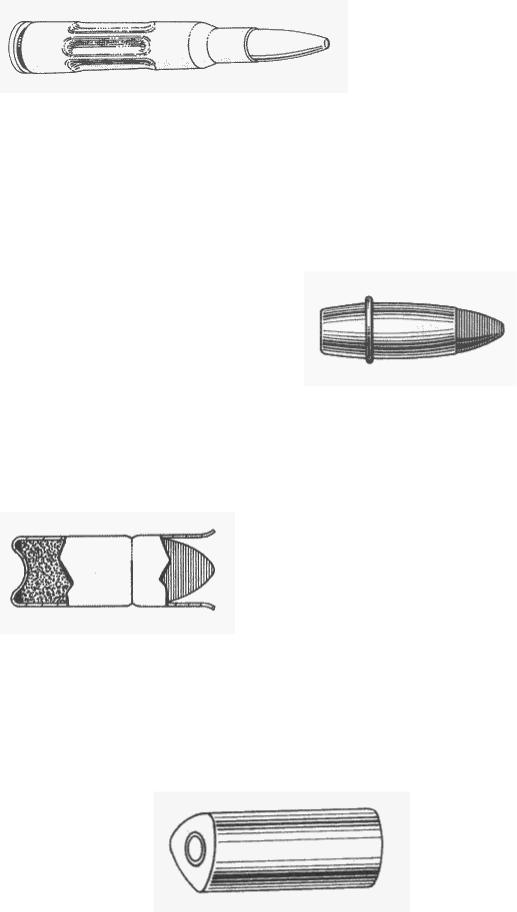
visual and tactile identification, mostly for dummy rounds. Short corrugations at the shoulder were also used on early .30-06 guard cartridges.
CREEDMOOR - The Creedmoor Range was a famous long range shooting site on Long Island, NY, in the late 1880s. The term has come to be applied to cartridges of .44 or .45 caliber of the type used in Creedmore Rules rifles.
CRISPIN CARTRIDGE - A distinctive type of rimfire cartridge where the fulminate is contained in an annular ring nearly midway between the base and mouth of the cartridge. The most common type is the .50 caliber version intended for use in converted Civil War Smith Patent carbines. It is also known in .44 and
.31 calibers. Patent #49,237, 8-08-1865.
CUPFIRE CARTRIDGE - A front-loading rimfire cartridge used in early pistols which were designed to circumvent the Rollin White bored-through cylinder design. The fulminate was distributed around the concave base of the cartridge. Known in .28, .30 and .42 calibers. Probably made by Phoenix or American Cartridge Companies. Some have raised A or P headstamps.
CUTAWAY CARTRIDGE - Any cartridge which has been sectioned to display its interior construction. Some are factory-made but most have been sectioned by collectors.
DARDICK CARTRIDGE - One of a family of experimental cartridges called "trounds" (Triangular ROUND) made for a family of patented guns and tools, starting in the mid 1950s. These are usually encased in plastic but occasionally
have metallic cases.
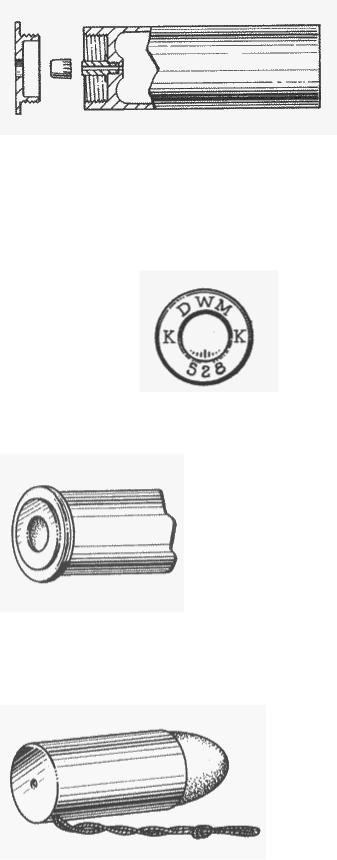
DRAPER CARTRIDGE - Actually a misnomer, these are really Wills Patent (#45,292 of 11-29-1864). A screw-off base reveals a percussion nipple. Several dozen variations are known in various calibers, lengths and base styles. A few (rare) rifle rounds are
also known. The bases are marked "Patented Nov. 29, 1864 F.D. & Co .
DRAW SET - A series of manufacturing stages of a cartridge case, bullet or primer.
DWM NUMBER - A caliber-identifying number or nurnber/letter combination which was used by the Deutsch Waffen und Munitionsfabriken (DWM) of Germany. Additional information such as date codes were sometimes included in
these headstamps.
EMBOSSED HEAD - A solid or formed-head cartridge whose base exhibits a raised circular portion of lesser diameter than the rim. Also called "Ring Base".
EXPRESS BULLET - See "COPPER-TUBED BULLET"
EXTRACTOR CORD CARTRIDGE - A rare Maynard experimental cartridge which utilizes a short length of cord to assist in extracting a fired case.
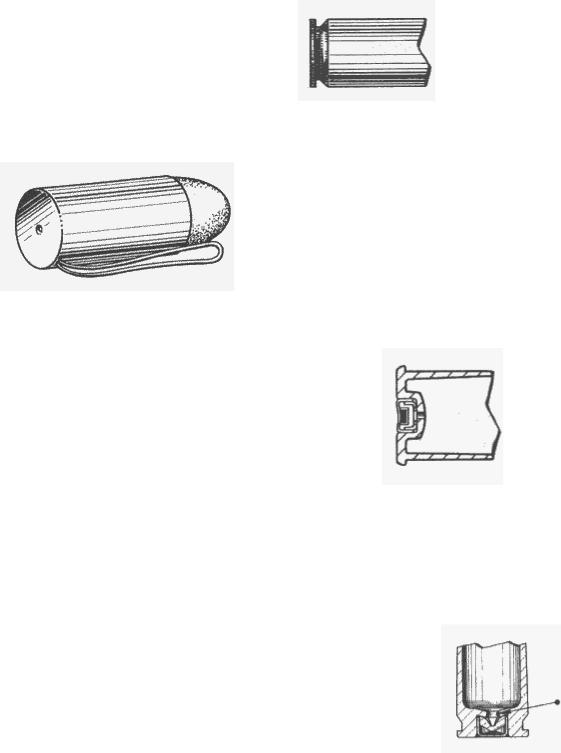
EXTRACTOR GROOVE - An annular groove machined into the cartridge case, usually just above the rim which provides a grip for the gun's extractor to pull the
fired or unfired case from the chamber.
EXTRACTOR WIRE CARTRIDGE - A rare Maynard experimental round using a short loop of wire attached to the cartridge's base to facilitate extraction.
FARRINGTON PRIMER - A distinctive style of primer, used primarily by the U.S. Cartridge Company in the late 1880s. Appearance is a very flat, nearly
concave copper disc, flush with the cartridge base.
FIXED AMMUNITION - Ammunition containing at least propellant and projectile as opposed to semi-fixed and separate-loaded ammunition wherein the propellant and projectiles are loaded separately. Modern usage applies to artillery ammunition.
FLASH HOLE OR VENT - One or more holes through the bottom of the primer
pocket to trans-mit the primer flame to the powder charge.
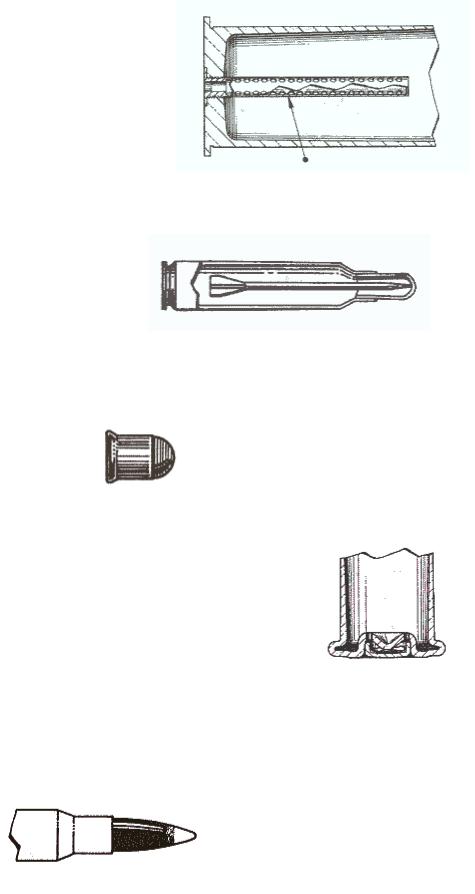
FLASH TUBE - A tube from the flash hole extended into the powder chamber, for
more uniform ignition.
FLECHETTE CARTRIDGE - A cartridge loaded with one or multiple finned steel dartlike projectiles. Many experimental varieties were made in the 1960s to
increase firepower.
FLOBERT - A small-caliber (9mm or smaller) rimfire cartridge, usually used for indoor shooting in Europe. Shot versions were used for collecting bird specimens. They often have elaborate raised headstarnps and many contained only primer
compound.
FOLDED HEAD - An early method of case construction in which the base is
folded to form the rim and primer pocket.
FRANGIBLE BULLET - A bullet made of various powdered and compressed materials which was designed to break up on impact rather than penetrate. During World War II, .30-06 frangible bullets were used for firing practice against specially armored aircraft. This type of bullet is made currently in various calibers.
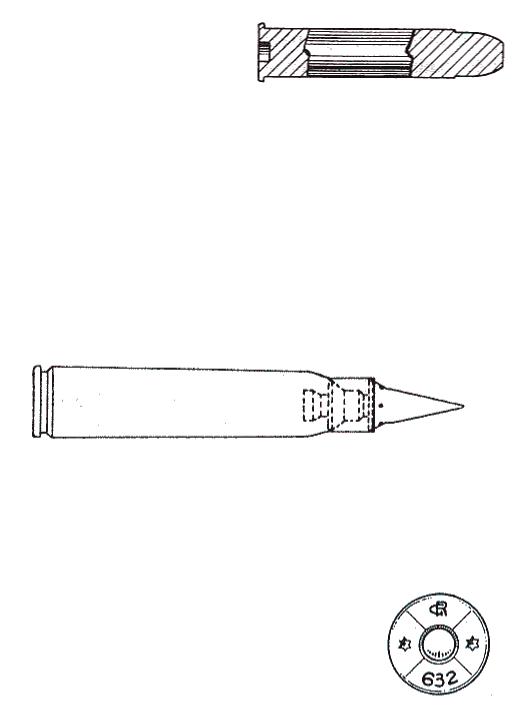
FUNCTIONING DUMMY - Usually a factory-produced inert round intended to demonstrate or test the action of a weapon without risk to the parties involved. They were often constructed more ruggedly than were conventional rounds and normally have visible identifying characteristics such as holes or cannelures in the
case or the coloring of the case.
GAUGE - A method of describing bore diameter of shotguns (usually), the number of balls of bore diameter which can be cast from a pound of lead. Thus a 12 Gauge" bore.
GERLICH - Hermann Thorismund Gerlich was a German experimenter in the late 1920s and early'30s whose investigations were largely oriented toward producing high velocities resulting from tapering the diameter of the bore from larger at the breech to smaller at the muzzle, thus giving a greater initial surface area and maintaining high pressure through a more efficient gas seal. Cartridges thus designed were distinctive and although success was sparse, the concept continued into recent times and examples are highly sought-after.
GILDING METAL - A metal alloy of 90 or 95 per cent copper and the remainder zinc.
GR NUMBER - A case type identification system used by the Austrian manufacturer, Georg Roth for their cartridges. These numerical designations were
often incorporated into the cartridge's headstarnp.
GRAVITY-FEED CARTRIDGE - Lead, self-contained cartridges used by the Loron, Gaupillat and other gravity-feed weapons. They are of the "volcanic" type, consisting of a pointed, hollow-based lead slug with priming compound located in
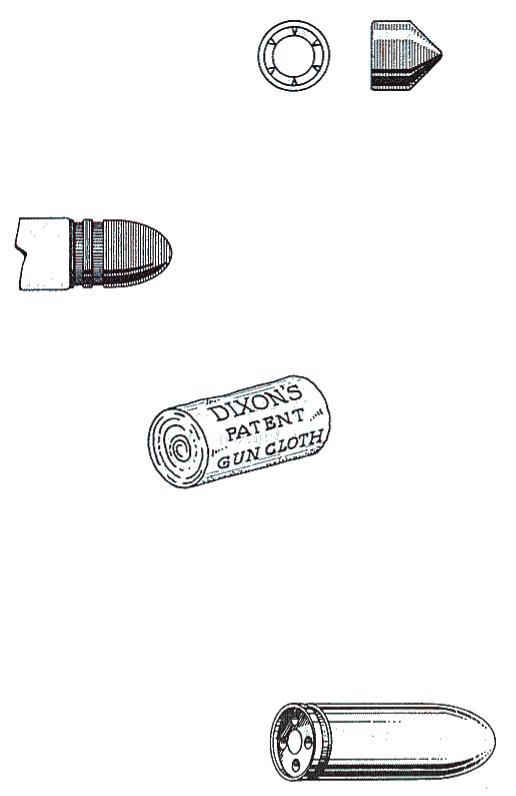
the base. As they were strictly indoor "salon" guns, there is no propellant other
than that in the priming mixture.
GREASE GROOVE - The circumferential groove(s) cut or cast around the body of a bullet to contain grease or other bore lubricant. These grooves are sometimes visible and sometimes located beneath the mouth of the case.
GUNCOTTON - A cellulose material which has been treated with appropriate chemicals to produce nitrocellulose, an extremely combustible material. Used as a
bullet propellant.
GYROJET CARTRIDGE - One of a series of relatively modern "rocket projectiles" developed and produced by the firm of M.B. Associates of San Ramon, CA, for use in their specialized guns. Consisting of a hollow metallic case which is filled with a propellant and with a percussion primer in the center of a base which contains slightly angled discharge orifices. Once fired the angled orifices cause the cartridge/projectile to rotate and accelerate. Although never particularly successful, a great variety of cartridge variations exist in various
calibers and include flare rounds.
HALGER - A brief partnership formed by GERlich and his bother-in-law, HALbe to com-mercialize high velocity weapons. A series of special HALGER cartridges
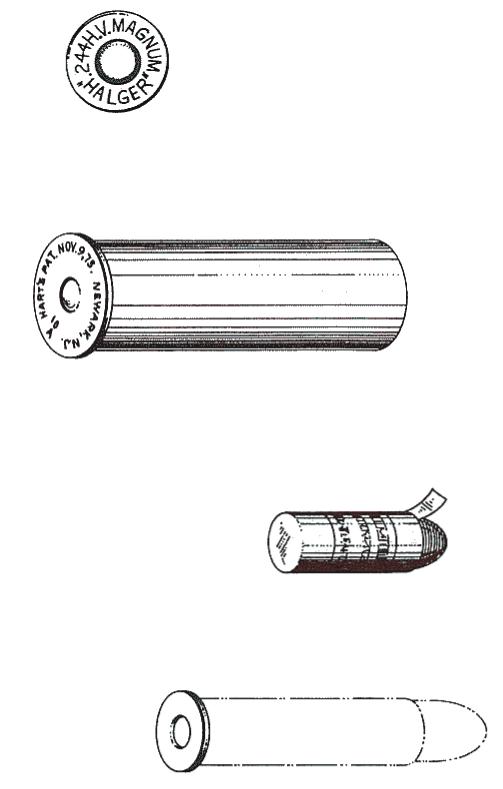
resulted from this partnership. All were produced in the 1920s and early'30s time
frame.
HART'S PATENT(S) - Metallic shotshells produced under Hart's various patents. Involved mainly in variations of head construction (#142,924 of 9-16-73; #151,121 of 5-19-74 (with Logan); 169,806 and 807 of 11-09-75).
HAYES' PATENT - British-made combustible cartridges for Colt, Tranter, Adams and other percussion revolvers. A delicate colloid-encased powder charge was attached to the base of the bullet and the whole encased in a paper tube for durability. A cloth tear tab assisted removal. Paper cases are often printed with
Hayes' name and various legends.
HAZARD PATENT - See Collodion
HEAD - The base portion of the case, including that part next to the rim or
extractor groove.
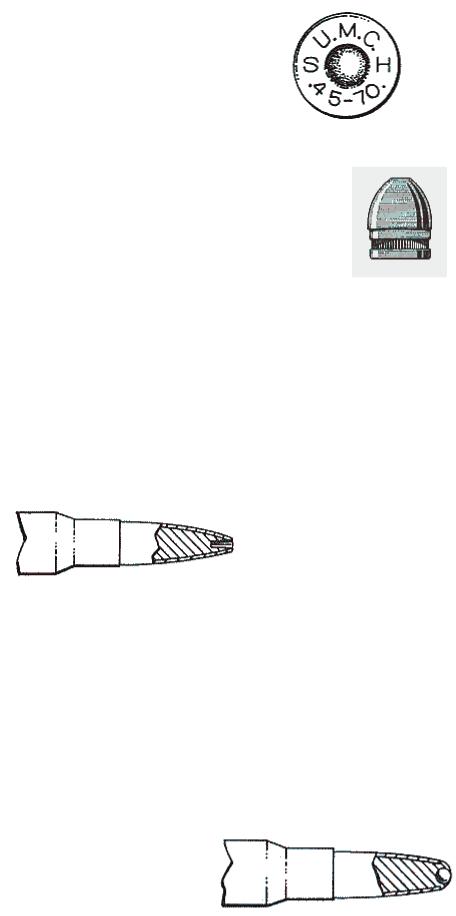
HEADSTAMP - The markings imprinted on the base of the cartridge case, usually containing information on the caliber and manufacturer or his logo; on military
ammunition, the date of manufacture.
HEEL-TYPE BULLET - A bullet with rear section of reduced diameter; so when
loaded, the front portion is flush with the case.
HIGH BRASS - Refers to the shotshells where the brass head extends 3/4 of an inch, more or less, up the case measured from the base of the head. Contrast to LOW BRASS or MEDIUM BRASS.
HOLLOW DUMMY - Inert cartridge consisting of empty case and bullet jacket. Often one-piece construction. Can be identified by its unexpectedly low weight. See FUNCTIONINGDUMMY.
HOLLOW-POINT BULLET - Bullet with a recessed open cavity at its tip. The intention is to assist in expansion and shocking power when impacting on flesh.
HORIZONTAL PINFIRE - Cartridge using a horizontal internal pin to impact upon the primer which is usually located at the base of the bullet. In such an instance, ignition starts at the bullet and progresses rearward, unlike most conventional cartridges. This was perceived to be an improvement in design at the time of development.
HOXIE BULLET - Produced by the Hoxie Ammunition Company of Chicago from 1907 to the '30s. Their bullets were characterized by a small steel ball embedded in the tip to aid in expansion on contact Mostly used for centerfire rifle calibers, they were also used in .22 Winchester Automatic rimfires, and often
require a magnet to detect.
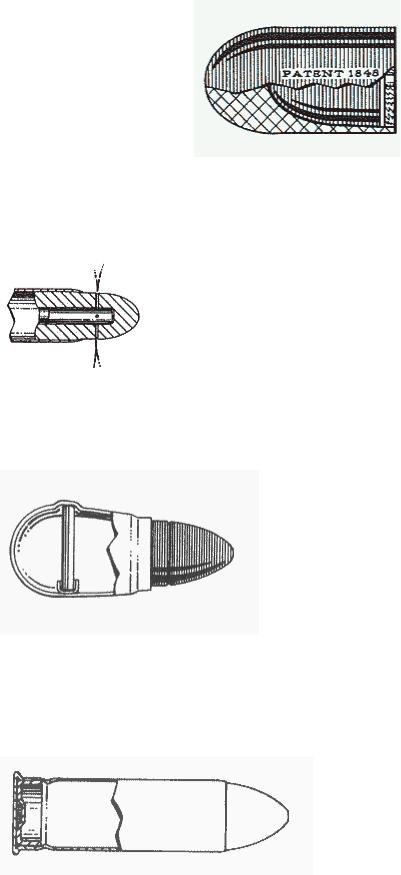
HUNT ROCKET BALL - Walter Hunt, on August 10, 1848 secured a patent (# 5,70 1) for... "a ball for firearms, with a cavity to contain the charge of powder for propelling said ball, in which cavity the powder is secured by means of a cap
enclos-ing the back end."
INSIDE-LUBRICATED BULLET - A patented bullet manufactured by UMC which was hollow and filled with grease. Upon firing, a piston was driven forward which forced the grease through tiny holes in the side of the bullet, greasing the bore. Identified by (usually) four tiny holes in the lead bullet.
INSIDE PINFIRE - A few types of extremely rare cartridges were ignited by the impact of the weapon's hammer on the wall of the cartridge case, causing ignition because of an internal mechanism including a rod or pin and priming compound. The classic Schubarth "egg" is an example of this type.
INSIDE-PRIMED CARTRIDGE - A generic term relating to a large family of non-reloadable, mostly centerfire cartridges where the primer was more or less integral with the case. The act of firing usually deformed the case to cause ignition. Many examples exist, most common of which are the BENET, MARTIN and BAR ANVIL rounds found in.50-70 Govt and.45-70 Govt.
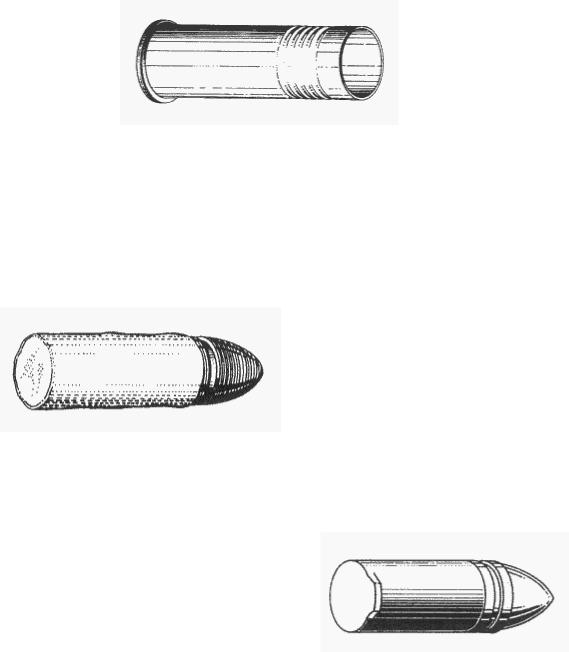
LACQUERED CASE - Usually a steel case which has been coated with lacquer for corrosion protection. Most frequently found with German WWII or Soviet bloc military rounds. Also found in shotshells to improve waterproofing.
LAWS PATENT - Albert Law's patent shotshell #131,104 of 9-3-1872 has a series of circumferential corrugations near the mouth of the brass case to retain the
cardboard wad.
LESMOK POWDER - Developed by duPont in 1911 and used by WRA, RemUMC and USC. It was a type of semismokeless powder and was used until the 1930s.
LINEN CARTRIDGE - Combustible cartridges, usually for Civil War breechloading longarms such as the Sharps and Starr carbines and rifles. The powder was contained in a starched linen sack with a nitrated paper base, which was fastened to me bottom of the lead bullet.
LIPFIRE CARTRIDGE - A form of rimfire cartridge patented by Ethan Allen (#30,109 9-25-1860) for use in his line of guns. A small fulminate-filled lip projects from the base rather than a full circumferential rim as found on common rimfires These were made in .25,32,36 and .44 calibers. The contention was that
they were safer than conventional rimfires
LOOSE PACK - Cartridges provided loosely packaged in cartons rather than being tightly and neatly organized. Usually found in small, difficult-to-package calibers such as .22 BB Caps.
